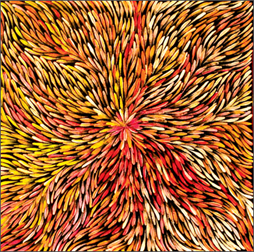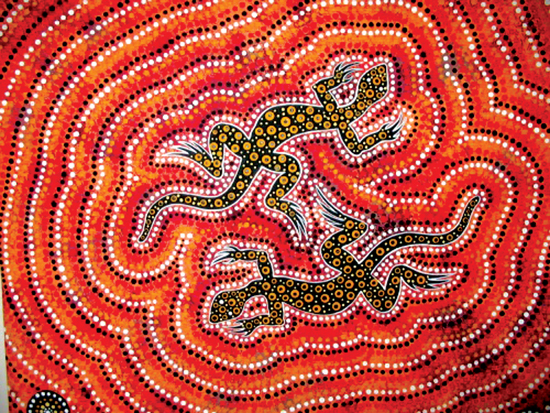Primitive art shapes cultures
 Visiting an exhibition of aboriginal art recently in Australia, I was
with friends. My slowness in moving from one painting to another was
commented on. Visiting an exhibition of aboriginal art recently in Australia, I was
with friends. My slowness in moving from one painting to another was
commented on.
"At this rate, we will be here till evening."
"This is a rare chance for me," I replied, I'm fascinated by the
stripes and dots. It borders on abstract art too."
"Well, don't let the dots and stripes hypnotise you," Chits chided.
 "Well then," said Ro, "we'll go our way and view the paintings and
we'll meet in the cafeteria when you finish," ok. "Well then," said Ro, "we'll go our way and view the paintings and
we'll meet in the cafeteria when you finish," ok.
Sam coming from behind said, "there are many rooms of exhibits. Take
your time and look at them thoroughly. It's taken you a long time to
come over from Sri Lanka to visit us."
"Thanks Sam. I'll have to give an account of all this to Charmtoo.
She couldn't join us today."
Sam smiled and moved on. I took my time in viewing the paintings. How
they had placed the fish and lizards, this way and that and filled the
intervening spaces with design. The colours of the bird wing were
vibrant. There were design paintings too. Some of them were of simple
form while most were intricately patterned. So, I spent a couple more
hours to finish viewing the exhibits.
When I joined the others at coffee, they all aksed me whether I had
viewed the art work to my satisfaction.
"Yes," I said, "many thanks for waiting."
"The coffee is real good here, so it's a pleasure."
"Did you see how they had painted the lizards, placing them in the
middle and the edges forming a pattern in itself?"
"Yes," Ro said, "reminds me of the golden gecko."
"Are you trying to impress us? What golden gecko?"
"It's a gecko found in the dry zone of the south east of Sri Lanka
and living in the boulder rock faces and caves. It has a light golden
colour and some have a white line running from the head backwards."
"Should we believe you?" piped in Sam.
"That's your wish, but the Vedda art was of them too. Veddas would
have used ochre from the earth and chunam white to make a light golden
colour."
"How did they get chunam or lime?"
"They needed the chunam as an intoxicant for their betel, which they
chewed daily. They had to burn snail shells to collected chunam."
"I wonder how they started painting with it?"
Merry added, "have we digressed now to Vedda art? You know that the
Veddas were mostly hunters. They would have been gone many days for a
hunt. Perhaps "the women folk who tended the family had to wait a long
time for the men to arrive. To appease the waiting they would have tried
out painting the cave walls. They would have transferred the images in
their minds to the walls of the caves."
Ro continued "Yes, there are paintings of elephants and leopards with
dots too. Why? We have seen these in Seligmann's book on Veddas. There
are some with detailed drawings in it too."
"Sometimes, the stick like figures of men have round heads. Short
lines radiate from these round heads either these depict the hair or
it's in the form of the sun god who they worship."
"You seem to have studied the Sri Lankan Veddas well."
"Yes," I read a lot on the Veddas as one of my pals recently
researched Sri Lankan folklore.
All this conversation and the aboriginal art exhibition brought to
mind the cave art of the Veddas. Veddas are the primitive inhabitans of
Ceylon/Sri Lanka. One theory that was put forth by R L Spittel, who
studied the Veddas assiduously, is that they were from the autochthonous
tribes of India who crossed over to Ceylon in prehistoric times before
the two lands were separated by inroads of sea.
The new arrivals evolved into many tribes who lived nomadic lives.
The men hunted for food and bee's honey while the women tended the
family. Bee's honey was gathered from trees and steep hilly rock faces
in arduous feats. Honey was a cherished food of theirs. They also
preserved strips of meat embedded in honey. In hunting, the men were
adept with bows and arrows. Their spears heads had pointed quartz.
Records show that quartz and chert were much used by them for tools and
implements. Lumps of black clay were moulded in rough round shapes and
burnt on the fires and clay pots were made. They believed in ancestor
worship and tree deities and had their rituals and ceremonies which were
full of music and dance. If they were in villages and had land plots,
the boundaries were marked on trunks of trees, with a figure of a man
and bow and arrow. There had been images scratched on ola leaves too. It
is recorded that in later times, Bibile, the Ratemahattaya of Bibile
area had an ola leaf with a scratched line representing a carrying
stick, to each end a circular object was attached which represented a
honey pot.
There were numerous Vedda tribes who lived in the area from Badulla
to Batticaloa. Many caves in this area in Nilgala hills, Pihilegodagalge
and Henebedda have art on the cave walls. There are figures, animals,
reptiles, scratched and painted on the walls. Perhaps, as Ro said, these
were done by the Vedda women.
 To describe some of the paintings, there are line drawings like
centipedes and smaller drawings of same. The bigger figures were leopard
and the smaller ones, the dogs. On the side, women and men were shown.
Lines drawn upwards from women's head showed that women had tied their
hair in knots. To describe some of the paintings, there are line drawings like
centipedes and smaller drawings of same. The bigger figures were leopard
and the smaller ones, the dogs. On the side, women and men were shown.
Lines drawn upwards from women's head showed that women had tied their
hair in knots.
The full painting depicted a hunt. In a later instance, a rock cave
painting depicted men on horseback. On one side there's a crowd of men
and women surrounding a man with a bow and arrow on his head. This was
explained as, when a leader Vedda was summoned to Batticaloa town for an
official purpose, he had come home and painted what impressed him most
of his visit.
The white men in Batticaloa town on horseback and the crowd was the
meeting. These paintings are photographed and described in detail in
Seligmann's book on "The Veddas." These Veddas painted their bodies and
faces for their ceremonial dances.
The paints used were ashes mixed with water and charcoal for the
leopard spots.
To keep the paintings intact some binder must have been used. Yellow
ochre of the earth and turmeric too had been used for colours yellow and
brown, as well as chunam or lime for the white marks. A certainty is
that much trial and error would have gone through on how to make the
paint last on the walls. These people living with nature would have
known about plant gums. Thus, some gum or some stiffening plant
substance would have been used with the mixed paints.
King Pandukabhaya (394-307 B C) in his struggle for kingship had the
assistance of the Veddas in defeating the ruling king, his uncle and
killing him and many of the king's brothers who were his uncles too and
thus gained the throne. Later, his Vedda allies were established on
three sides of his city for defence purposes. It has been recorded that
Veddas were used as a spy network system in the many battles that raged
during the reigns of our kings.
In similar vein, the aborigines of Australia who are dark skinned
people belonging to the Australoid group have roamed the Australian
continent for thousands of years. They have similar traits to that of
the Veddas , in worship of ancestors and deities, art and craft and
music and dance. This fact is full of wonderment as Australia is a vast
continent and Sri Lanka, a little tropic isle.
Cave art of Australia is seen in Central Queensland. Aboriginal art
is full of animals, kangaroos, crocodiles, birds and fish. In the
beginning, these were painted on rock walls of caves as well as barks of
trees. There are many aboriginal tribes although they share a similar
way of life and religious beliefs. These separate groups have different
languages, legends, histories and ceremonies. Mostly nomadic by nature,
they trek miles in the bush land before setting up camp. The tribes from
Northern Australia have spirit figures for painting. Dreaming, a type of
art, is said to be done by actual ancestral beings rather than work of
humans. People inherited these paintings and they were responsible to
freshen them with colour, repair and repaint them from time to time.
Because of different tribes, there is a wide variety of art work by
the aborigines. In the beginning they painted on cave walls, on the
ground and on stones. Their colours unlike that of the Vedda art, are
vibrant just like the colourful birds that fly overhead.
They use their hands for painting and their fingers to do the dot art
work that is a special characteristic of the aboriginal art. They have
developed this art into such intricate patterns and now is well-known in
the world. Some of their patterns, especially, lizards and crocodiles,
fish and birds are done so well in the paintings in a form that
signifies cubism art as well.
The cave art of Central Queensland show large paintings made by
blowing mixture of red ochre and water over mouth and hand of objects,
for example, boomerangs, etc. Also net like figures are painted with
twig brushes. Many animals, reptiles, birds and stick like figures too
are painted found in their abundant fauna.
The verdant coastal belt of Australia have such colourful bird life,
like the parrots, lorikeets, cockatoos, kookaburras, as well as big emus
and the dancing lyre bird. The kangaroos, wallabies and the koala too
add the special effects. All this plus the splendid sunsets and the red
earth and rock of the centre of the continent gives them all the colours
they need to enhance their artwork. How strikingly the aborigines
painted their bodies. Sometimes they looked fearsome too thus painted.
Especially, the white stripes and marks stand out on their dark skins
very vividly.
Another close enough island to Australia is New Zealand where the
indigenous people are the Maoris. The Maoris are believed to be a
Polynesian type of people who arrived over thousands of years ago.
Linguistics and culture suggest that Maoris travelled from Cook Islands.
Maybe they arrived following the migratory birds who fly these paths
even now. Wood, bone and green stone or jade carvings were art as well
as necessity. These provided the tools and weaponry to catch, propagate
and prepare food, then came the growing need to protect property and
possessions. These skills led to design and implementation of weaponry
for close quarter fighting.
Maori cave art had charcoal, red and yellow ochre pigments used. The
Koru, the fern frond was a favourite motif of the Maoris. The dried
pigments disintegrated and faded. This gave rise to other pigments mixed
with oil binder which made images more durable. Drawings were of human
figures, moa and birds and fish. Also those of extinct pouaki (Haast's
eagle), canoes and mythological figures. Certain amount of romance
surrounds the history and discovery of the Moa. It is believed to be a
struthious bird, larger and more colossal than the ostrich. The pouaki
was a giant eagle who could carry human beings to its nest. Certain
amount of scientific basis for such birds are in the fossil bones of
gigantic birds found in the country. Most probably they were prehistoric
birds.
Maori art shows that tattooing of men are more elaborate than women.
High ranking men were decorated with intricate tattoos on their faces
and buttocks. Women of similar prestige wore facial tattoo.
The meeting houses are very important to the Maoris. These are the
most decorated houses in the village. If another house is more
elaborately carved and painted, then it is an insult to the tribe. Here,
the reflection of tradition, spirit and history are seen in the carvings
and design in and around the house. The area in front of the meeting
house was also important. Sometimes, even more important than inside,
having intricately carved totem poles too. Inside the house, the
carvings of figures of ancestors and Gods tell the story of tribal
history. Maoris gather in this meeting house to mourn, celebrate as well
as discuss important matters.
Weaving included wall panels in meeting houses and other important
buildings as well as clothing and bags. These took long hours to weave.
The main medium of weaving was flax. Later, wool and other textiles were
used. Most of the weaving was done by women and turned out to be works
of art.
Though the Maoris may not have written or recorded history, the
carvings and tattoos and totem poles show way of preserving the past.
These facts show that the Maoris were disciplined and had the knowledge
to keep their tribes together.
The Veddas are slowly but surely integrating with the other people in
Sri Lanka but there are a brave few who still try to keep their
traditions and way of life. They shy away from the modern pace of life
and live in the calming jungles. They still carry an axe on their
shoulder. If they come for an official function to town, they come with
their top body naked and wearing an axe on the shoulder. The aborigines
of Australia still live their nomadic life in the bush.
Their arts and crafts are well-known and well received in the world.
They still demonstrate to have all their rights as natives of the
country of wanting their land. For this purpose they have put up some
tents in front of the old Australian parliament. They have their flag
flying on a flag pole there. They live in the tents and they tend an
undying fire. This shows their tenacity to their land. Similarly, one
Vedda leader, Tissahamy and his kinfolk of Kotabakinni, refused to be
evicted from the land of his ancestors during the 1987 Master Plan for
the Maduru Oya National Park. Officials considered him to be very
obstinate and stubborn for he would not budge an inch, no matter what
emissaries came to "talk sense" to him. Finally, the government of Sri
Lanka had to concede that Tissahamy and his clan of seven families could
remain on the land till Tissahamy died. Then the families would have to
evacuate the hamlet immediately. As a note of interest, Tissahamy
expired in 1998 at the reputed age of 104.
The Maoris have integrated well into the main stream of society in
New Zealand. They show independence with their traditions and have their
own schools and their language too is in practice. They are a huge
tourist attraction in New Zealand with their war canoes, the haka and
their song and dance rituals. They are a handsome people in contrast to
the Aborigines and the Veddas who have an unkempt appearance.
It is a great wonderment to see how these tribes have existed for a
long, long time, holding fast to their beliefs, traditions, art and
craft and their way of life in a modern world of development. They live
parallel with great advancement in science and technology.
In this day of modern art work and graphics, they still cling to
their traditional art and craft. This is how cultures are shaped. These
tribal people are like us living in Sri Lanka, the Sinhalese, the Tamils
and the Moors, all make up the mainstream of society but each have and
take pride in their separate cultures. Taking all into account, the
unwavering dedication of the aforementioned primitive tribes to their
art and craft should be well commended and given a distinct place. |

